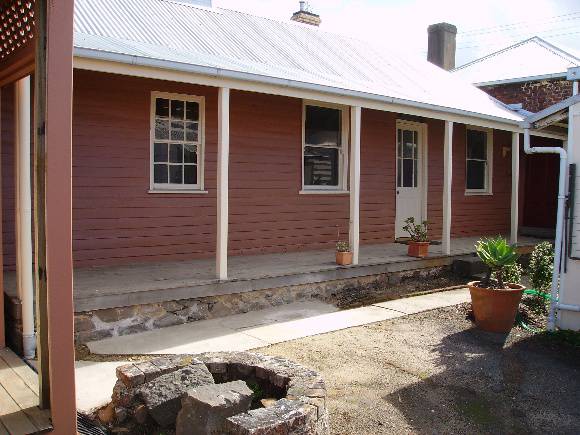| Back to search results » | Back to search page » |
|
COTTAGE AND SHOP
Location15-17 GAWLER STREET PORTLAND, GLENELG SHIRE
File NumberPL-HE/03/1187LevelRegistered |
|
Statement of Significance
What is significant?
The complex at 15-17 Gawler Street, Portland is made up of a c. 1849
weatherboard cottage, with a c. 1855 weatherboard addition and an 1860
brick and stone shop. The site is a subdivision of Lot 10, Section 2
of the 1840 town survey. Portland, the earliest permanent settlement
in Victoria, developed quickly from the 1840s and its economic
importance as a port grew throughout the nineteenth century. Thomas
Kean, the customs boat coxswain, arrived in Portland in 1845, and
moved to Gawler Street soon after 1846. He subsequently constructed a
number of buildings on the site, for both residential and commercial
purposes. The three-roomed weatherboard cottage was constructed c. 1849, and
consisted of a bedroom and kitchen, accessed through a central main
room. Set back from Gawler Street, the residence faced east towards
the bay, and is depicted on the 1853 Birmingham map of Portland, along
with a smaller structure to the rear. Its simple design and hand-sawn
weatherboard cladding are typical of pre-gold rush structures, and it
is one of the earliest remaining buildings in Portland. From 1852, Kean operated an 'establishment for the manufacture of
tents, tarpaulins' from the property, and as his business developed,
so did the buildings on the site. In 1855 tenders were advertised in
1855 for the 'building of additions to Kean's Premises in Gawler
Street'. The resulting addition at the rear of the allotment began as
a small weatherboard structure and at one time extended the full width
of the site to the laneway. It was likely to have been associated with
Kean's ships chandlery operations. The two-roomed brick shop, facing Gawler Street, was constructed by
Kean in 1860, when the area was developing as Portland's commercial
district. At the time that Kean worked as a ship chandler and on
customs boats, Portland was one of Victoria's major ports. It was from
the Gawler Street premises he ran his 'Tent & Dray Covers'
business, which operated until at least the late 1880s. The shopfront
was made up of two large, wooden framed windows and a central doorway
and was connected to the cottage by an internal doorway. A number of other buildings constructed on the site during the late
nineteenth century have since been demolished and a c. 1930s timber
cottage now occupies the north-east corner. The c. 1855 weatherboard
addition has been reduced in size since its largest incarnation
stretching to the laneway by the 1870s. More recently, conservation
work has been undertaken, restoring many original features.
How is it significant?
The buildings at 15-17 Gawler Street, Portland are of historical,
architectural and archaeological significance to the State of Victoria.
Why is it significant?
The cottage and shop complex at 15-17 Gawler Street is of historical
significance as one of the oldest remaining residential and retail
premises in Portland, the earliest settlement in Victoria. The c. 1849
cottage is significant as a rare surviving example from the pre-gold
rush period, and is an example of a simple dwelling style which was
once common in Victoria. The complex of three buildings is significant
as a whole for demonstrating the development of Portland's early
commercial precinct. The late 1840s weatherboard cottage at 15-17 Gawler Street is of
architectural significance for its simple, pre-gold rush style
demonstrating early building techniques and evidence of the use of
recycled materials, possibly from boats. The shop is important for
demonstrating typical 1860s retail design. The site is of archaeological significance for its potential to
contain deposits relating to the former use of the site for ship
chandlery and residential purposes in the nineteenth century.
Group
Residential buildings (private)
Category
Cottage






